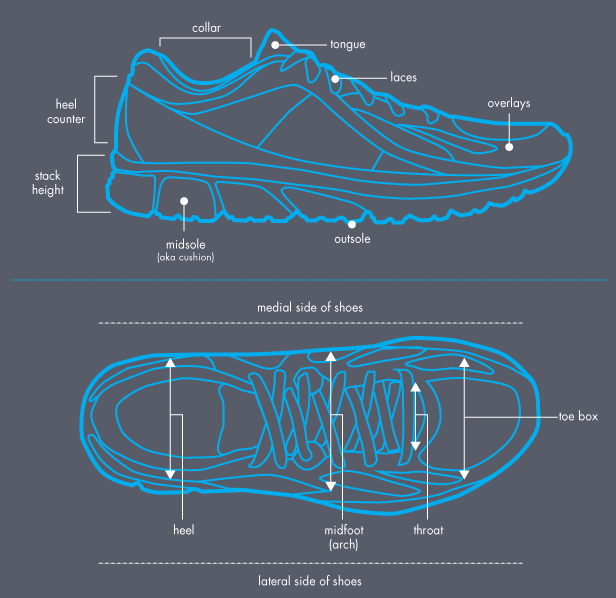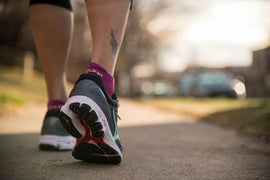
هل سمعتَ يومًا عدّاءً يقول بحماس: "يا أخي، ما هذا الفارق بين الكعب والأصابع؟" أو "يا أخي، نعل حذائك مُذهل!" وأنتَ تقفُ هناك مُندهشًا... اشتريتُ هذه الأحذية لأنها مريحة... جميعنا مررنا بهذا من قبل. نتوءات؟ ارتفاع مُتكدس؟ لسان مُقوّس؟ ما كل هذه المصطلحات؟
لا تقلق، سنساعدك! سندرس بعض التشريح، ليس أي تشريح، بل تشريح حذاء الجري. لذا، استعد، لدينا بعض الدروس لنتعلمها.
تشريح حذاء الجري
يتكون حذاء الجري بشكل أساسي من ثلاثة أجزاء. الجزء العلوي، وهو أول ما تقع عليه أعين غير العداء، والجزء الأكثر تعقيدًا هو النعل الأوسط، والجزء الأسهل فهمًا هو النعل الخارجي.
أجزاء مختلفة من حذاء الجري

الصورة بواسطة: believeintherun.com
العلوي

الجزء العلوي هو ما يُتيح التهوية للحذاء. وهذا يعني أن قدميك ستكونان أقل تعرقًا بكثير لأن الشبكة والقماش يسمحان بتدفق الهواء. على أي حال، ننتقل الآن إلى أجزاء الجزء العلوي.
- لسان: هذا هو الشريط الذي تسحبه قبل ربط الدانتيل، مما يُساعد على تخفيف ضغط الدانتيل.
- عداد الكعب: هذا الجزء هو الذي يقفل الحذاء حول كعبك بشكل آمن ومريح.
- طوق الكعب: يقع هذا النعل فوق منطقة الكعب مباشرةً، مما يوفر التبطين والحشو حول الكاحل لضمان ملاءمة مريحة ومحكمة.
- الأربطة: واضحٌ جدًا، أليس كذلك؟ إنه ما تربطه بعد الانتهاء من ارتداء الحذاء. من الواضح أن بعض العدائين يستمتعون بمقاس مريح للغاية، لكن...
- التراكبات: هل لاحظتَ الزخارف المُزخرفة على الحذاء؟ إنها أكثر من ذلك، فهي غالبًا ما تُصنع من مواد عاكسة لزيادة الرؤية ليلًا. يمكنكَ اعتبارها شريطًا مُقوّيًا يُضفي على الحذاء شكلًا مُتناسقًا.
- صندوق أصابع القدم: هذا هو المكان الذي ترتاح فيه أصابع قدميك وتتحرك فيه، تأكد من وجود مساحة كافية لها لأن قدمك تتورم قليلاً أثناء الجري. نوصي عمومًا بمسافة عرض الإبهام بين طرفي الحذاء. نطلق على هذه المسافة اسم "اختبار الإبهام".
النعل الخارجي

الصورة بواسطة أندرو ريد
الجزء السفلي من الحذاء مُزخرف بنقوش مطاطية أنيقة. تُجري كل شركة أبحاثًا مُكثّفة لإنتاج أفضل أنواع المطاط المُناسبة لأحذيتها. هذا ما يجعل الحذاء متينًا. وحسب نوع التضاريس التي تركض عليها، قد يكون النعل الخارجي مُجزّأً لسهولة الحركة على الطرق المعبدة، أو قد يكون له نمط نتوءات قويّ يُشبه النتوءات لضمان ثبات أكبر على التضاريس الوعرة.
- العروات: هل تذكرون أننا ذكرنا العروات في البداية؟ إنها مجرد أخاديد صغيرة تُعزز الثبات على التضاريس الوعرة. ونراها غالبًا في أحذية الجري على الطرق الوعرة.

الصورة بواسطة سليمان
- جسر المشاة: وتعرف أيضًا باسم الساق، وهي تعمل على توفير دعم إضافي عن طريق تقليل التواء الحذاء.
النعل الأوسط

صورة فوتوغرافية بواسطة كارلوس ألفاريز
هذا هو النعل الأوسط، النواة، النجم، والمغني الرئيسي الذي يتذكره الجميع، "النعل الأوسط". الجزء الذي يوفر "عودة الطاقة" المُقدسة. ليس الأمر معقدًا جدًا لفهمه، عودة الطاقة هي الارتداد أو النبض الذي تشعر به داخل الحذاء بعد ملامسة القدم للأرض.
في الأساس، يتكون النعل الأوسط من رغوة متخصصة. عادةً ما تُستخدم رغوة EVA (مركب كيميائي قد لا يتذكره معظمنا).
تتمتع العلامات التجارية الكبرى بعلمها الخاص لإنشاء المواد الهلامية والرغوية الخاصة بها لتوفير أفضل قدر ممكن من التبطين وامتصاص الصدمات.
ارتفاع المكدس: هو قياس سُمك الرغوة، أي كمية الرغوة بين قدمك والأرض. كلما زاد ارتفاع الرغوة، زادت قدرة الحذاء على التبطين.
خاتمة:

لقد قمنا بتغطية الكثير من الأمور، لذا دعونا نلخصها، أليس كذلك؟
لقد قمنا بتغطية الجزء العلوي وهو الجزء الذي يحتوي على طبقات مما يجعل الحذاء جذابًا للنظر.
النعل الأوسط، وهو جوهر حذاء الجري. لدى الشركات تقنياتها الخاصة في تصنيع الرغوة والجل. هذا ما يميز حذاء الجري الجيد عن حذاء الجري المتوسط.
وأخيرًا، النعل الخارجي هو ما يلامس الأرض. وتختلف أنواع النعل الخارجي باختلاف الأرض التي تختار الجري عليها.
هذا يوصلنا إلى نهاية دليل المبتدئين لفهم حذاء الجري. ستكون أقل حيرةً في المرة القادمة التي يبدأ فيها عدّاءٌ بالحديث عن حذاء الجري.

